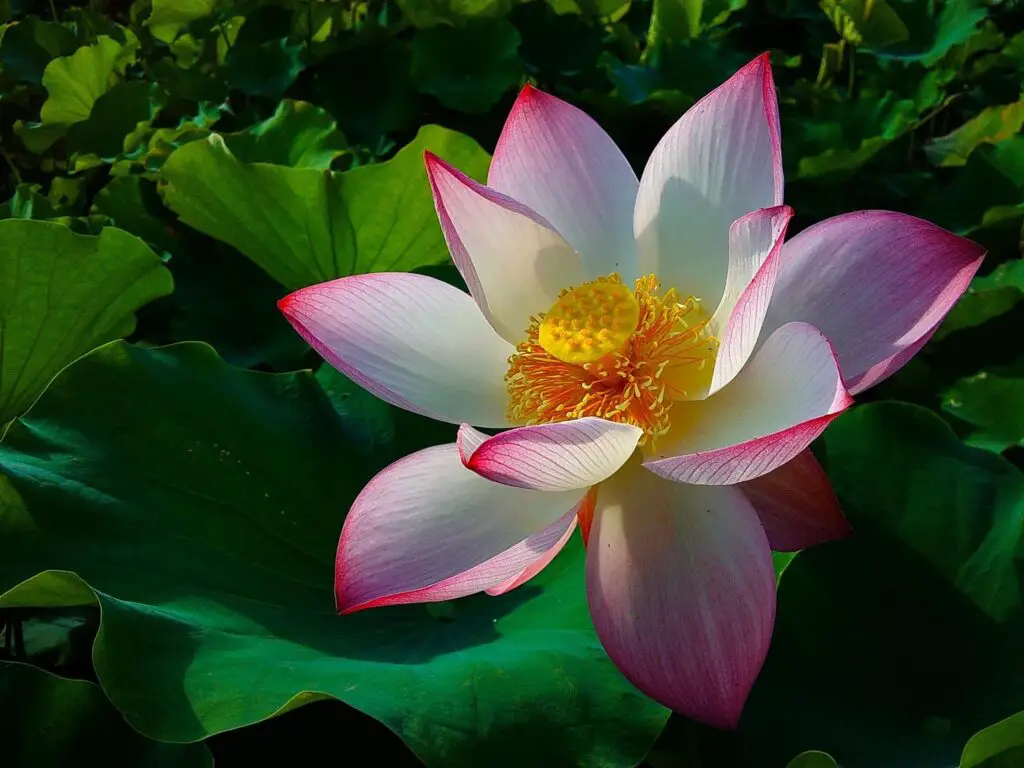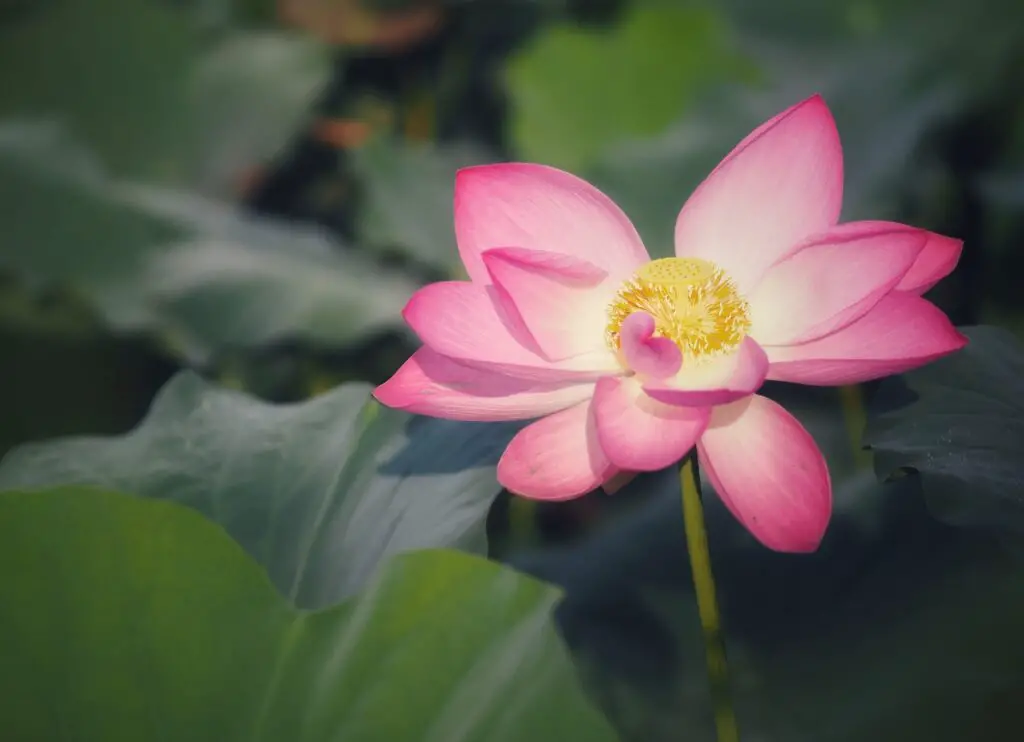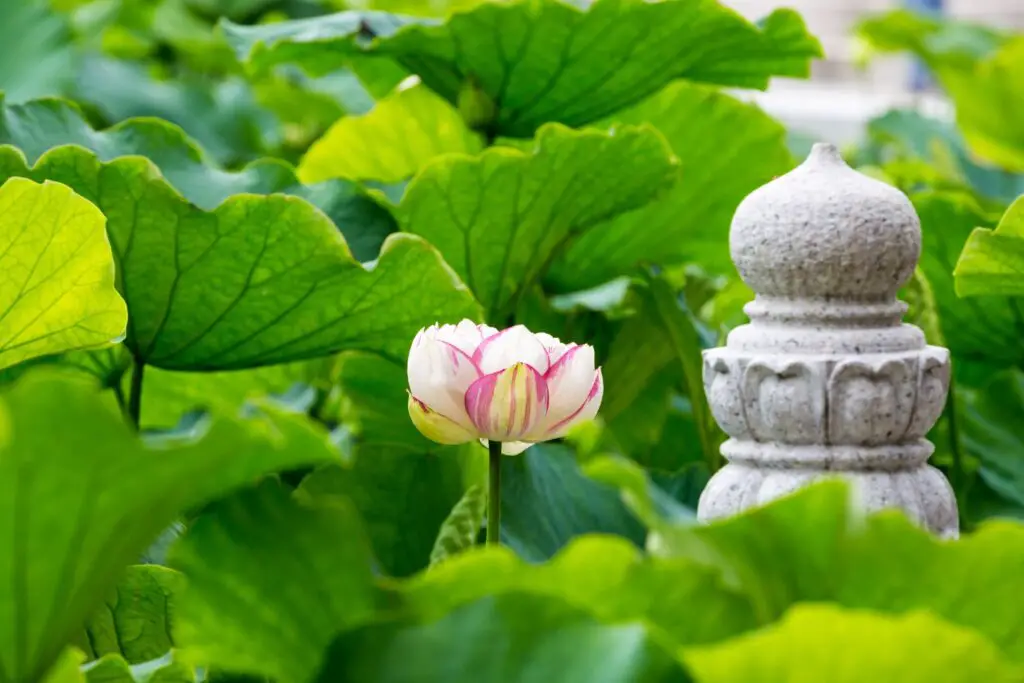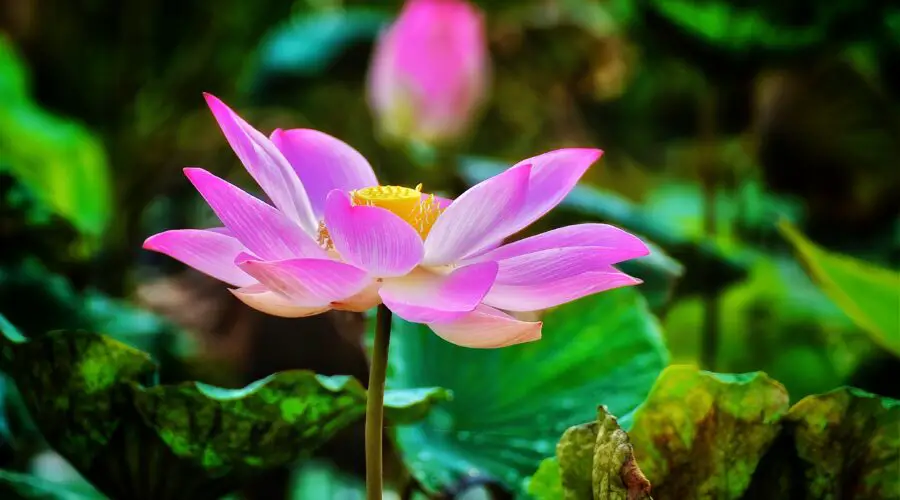Lotus Flower Meaning and Symbolism
In the world of flowering aquatic plants, Lotus is a queen of flowers. Its roots are in muddy water, but the plant produces the most beautiful flower. Besides its beauty, Lotus is known for its symbolic meanings, symbolizing different things to different cultures and countries. This is the story of the Lotus, its origin and its symbolic meaning.
What Does the Lotus Flower Mean?
The common name “Lotus” is used as a common name for many species and genera in various botanical families such as Saussurea genus (commonly known as “Snow Lotus”), the species Ziziphus Lotus in the Ziziphus genus, the species Diospyros Lotus of the genus Diospyros and for certain species of the genus Nymphaea (Nymphaea nouchali, Nymphaea lotus).
In modern times, the term “Lotus” refers specifically to the genus Nelumbo of the family Nelumbonaceae. Nelumbo is a genus of aquatic plants consisting of only two species – Nelumbo nucifera and Nelumbo lutea. Nelumbo nucifera is native to tropical Asia and Australia, while Nelumbo lutea is native to North America. Both species occur in humid areas along lakes, lagoons, swamps, ponds and waterlogged fields. They are characterized by wide, disc-shaped flowers on thick stems. The flowers come in white, pink, red, blue and purple, and each color has different meaning. They all have pleasant smell and people simply adore them.
In our article, we use the term “Lotus” to refer to both the Nelumbo and Nymphaea species. They are both aquatic plants that have long been called “Lotuses”. The main difference is that Nymphaea species have leaves and flowers that float on the water’s surface, while Nelumbo species have leaves and flowers that rise above the water’s surface.

Nelumbo nucifera (Indian Lotus or Sacred Lotus)
Importance of the Lotus Flower in Eastern Culture
Lotus is one of the most popular flowers in Eastern culture and can be found in most parts of Asia and Australia. Both Nelumbo and Nymphaea plants are popular in the East, but Nelumbo nucifera is more popular because of its cultural and religious significance.
The Lotus has different meanings throughout different cultures and time periods, but the general concept is the same. The story behind the meaning of the Lotus flower comes from its ability to push through the mud in order to bloom and grow. In Hinduism and Buddhism, it’s considered the most sacred flower that has great spiritual symbolism.
What makes the Lotus so unique and why is it so popular?
The Lotus Flower in ancient Egypt
In ancient Egypt there were two types of water lilies that grew in the Nile. One was the Blue Lotus or Blue Egyptian Lotus (Nymphaea nouchali var. caerulea) and the other was the White Lotus or White Egyptian Lotus (Nymphaea lotus). Both species have been part of their mythology and culture for thousands of years.
The Blue Lotus flower, scientifically known as Nymphaea nouchali var. caerulea and sometimes also called Blue Water Lily, was the most commonly portrayed in the temples and tombs, which indicates its significance to the Egyptian people. As a state symbol, the Blue Lotus was used to symbolize the union of upper and lower Egypt. It was one of the most important ritual plants used both for funerals and joyful occasions. It was known as a sacred shamanic herb and was integral part of their ceremonies and artwork. The ancient Egyptians used this plant as a narcotic both for its healing qualities and as a recreational drug. They associated it with the sun god Ra, who was believed to push the sun through the sky every day. The plant was therefore linked with the rising and the setting of the sun, as it “sleeps” in the mud every night and resurfaces each morning, symbolizing the rebirth and new beginnings. The Blue Lotus also symbolized immortality and eternal life to the Egyptians. It was often used in funerals and after death traditions. It’s also worth to mention that this plant was found scattered over Tutankhamun’s body in 1922 when the Pharaoh’s tomb was opened.
Today, the plant is listed as endangered and is used for ornamental and medicinal purposes. Medicinally, the plant is used for its natural calming effects. It is used as a sleep aid, but also to reduce anxiety and stress levels. Despite the popularity of the Blue Lotus in Egyptian history, the White Egyptian Lotus is adopted as the national flower.

Nymphaea nouchali var. caerulea (Blue Lotus or Blue Egyptian Lotus)
The Meaning of the Lotus Flower in Ancient Iran
The Lotus also had special significance in ancient Iran. The ancient Persians considered this beautiful flower as a symbol of purity, spiritual growth and feminine existence. In the Persian calendar, 27th June (or 6th Tir) was the celebration of the Lotus flower, which signifies that it was of high importance in ancient Iran. The influence of this flower can be seen in the Persian architecture and art.
In Iranian mythology, the Lotus flower is considered to be the flower of Anahita, the goddess of fertility and pure waters. By thinking about the history of Persia, we see that in Zoroastrianism, which was the main religion in ancient Persia, this flower was the symbol of Ahura Mazda, the creator and highest deity of Zoroastrianism. In Zoroastrian tradition, the Lotus is a sacred flower that is able to shine even in the middle of impurity, just like human beings.
The Lotus Flower in India
Just like in other Eastern cultures, the Lotus has also been popular in India from ancient times. Nelumbo nucifera was chosen as the national flower because it enjoyed a significant presence in the ancient mythology and folklore of India. It also occupies a unique place in Indian art history. The plant is widely known as Indian Lotus or Bean of India because of its importance to Indian history.
The Lotus enjoys a sacred status in Indian culture. It is an integral part of Hindu ceremonies and rituals and is one of the most widely available flowers in India. The famous Lotus Temple, located in New Delhi, is one of the seven Baha’i Houses of Worship. The Bahá’í House of Worship is a place of worship of the Bahá’í Faith, a global religion that originated in Iran in the early 19th century. The temple has a stunning architectural beauty and is open to all regardless of religious, spiritual or secular perspective.

Lotus Temple in New Delhi, India
The Importance of the Lotus Flower in Chinese Culture
In China, the Lotus symbolizes purity, harmony, divinity and enlightenment. Its symbolism comes from Buddhism and is considered one of the “eight precious things” in the tenets of Buddhism.
The Lotus flower is admired by the Taoists as well. Taoism is the second major religion practiced in China where the Lotus flower has historical and cultural significance. In the Taoist culture, the Lotus signifies wisdom, morality, purity, harmony and immortality, but it can also symbolize beauty, life and partnership. It is known as the Gentleman’s flower because of its purity and elegance.
The Lotus has been used in Chinese medicine and cuisine for more than 1000 years. It is also a popular flower to use in Chinese weddings. In summer, the Lotus flowers are in full bloom and it’s absolutely stunning.
The Lotus Flower in Thailand
In Thailand, flowers are very important and have been used for centuries for medicinal and ornamental purposes. The Lotus is very popular in the lives of Thai people and is daily used in offerings and ceremonies. It is recognized as a symbol of purity, wisdom, spiritual awakening and feminine beauty. It is also associated with Buddhism and Hinduism, where it is a spiritual and ritual symbol.
Apart from its use in religious celebrations, it can also be found in religious art and architecture. A great example of this is the Bamboo Sports Hall of the Panyaden International School in Chiang Mai, which is designed to mimic a Lotus flower. The most popular place to see Lotus flowers is at Talay Bua Daeng (or Red Lotus Sea), which is located in Udon Thani, Northeast Thailand.

Lotus flowers in full bloom at Talay Bua Daeng (Red Lotus Sea or Red Lotus Lake) in Udon Thani, Thailand
Significance of the Lotus Flower in Vietnam
The Lotus is regarded as an unofficial national flower of Vietnam. It is considered as a symbol of purity, commitment, hope and optimism. The Lotus is honored by the Vietnamese as a symbol of nobility and wealth, but it can also symbolize health, honor and knowledge.
This beautiful plant is often cited in the Vietnamese poems and songs, and is used in both traditional medicine and culinary practices. It makes for a beautiful garnish for salads or teas and can also be utilised to decorate special food. As well as being Vietnam’s unofficial national flower, the Lotus is also the symbol of Vietnam Airlines. The Vietnam Airlines logo is “Golden Lotus”, which symbolizes the company’s dramatic improvement since its establishment.
Symbolism of the Lotus Blossom in Japan
The Lotus is also popular in Japan, especially among the Buddhist community. In Japanese culture, this flower represents purity and spiritual enlightenment. It is appreciated because of its ability to rise from the mud and bloom into a beautiful flower. Shinobazu Pond in Tokyo’s Ueno Park is the perfect place to see Lotus flowers. In summer, these flowers come into bloom and everything starts to look beautiful and alive.
The Lotus Flower in Bangladesh, Sri Lanka and Indonesia
The Lotus is also a popular flower in Bangladesh, Sri Lanka and Indonesia.
Nymphaea Nouchali, also known as Star Lotus or by its synonym Nymphaea stellata, is the national flower of Bangladesh and Sri Lanka.
In Bangladesh, the plant is known as Sada Shapla and has been the national flower since 1971. It represents purity, strength and unity of the people of Bangladesh, and is often used in religious ceremonies throughout the country.
It was declared the national flower of Sri Lanka on 26 February 1986. The flower is also known by Sri Lankan people as Manel Flower and can be found growing in shallow waters in all parts of Sri Lanka.
The Lotus can also be found throughout Indonesia and other parts of Southeast Asia. It has a great significance in Balinese culture and spirituality. Bali is the only Hindu-majority province in Indonesia, with 83.5% adhering to Balinese Hinduism. In Balinese Hinduism, the most prominent feature in most temples is the padmasana or “Lotus Throne”, an open seat-type shrine reserved for the most important deity Sanghyang Widi Wasa. Saraswati Temple, officially Pura Taman Kemuda Saraswati, is a large temple located in Ubud, Bali. It is also known as the Lotus Temple and is famous for its Lotus pond dedicated to the Hindu goddess Saraswati, the goddess of learning, wisdom, literature and art. In Balinese culture, the Lotus flower is the “king of all flowers” and represents grace, beauty, purity and transcendence.

Pura Taman Kemuda Saraswati (Ubud Water Palace) in Ubud, Bali, Indonesia
Meaning of the Lotus Flower in Hinduism
Lotus is a sacred symbol in Hinduism associated with beauty, fertility, prosperity, knowledge, spirituality and eternity. It has been a religious symbol in Hindu culture much before Buddhism came into picture as a religion. The Hindu tradition believes that Lord Brahma was born from a Lotus flower sprouted from the navel of Lord Vishnu. Other Hindu deities are also associated with the Lotus flower. For example, the Lotus is commonly associated with Lakshmi, the Hindu goddess of wealth and prosperity. She is often depicted sitting upon a Lotus or holding a Lotus flower. Saraswati, the goddess of learning, wisdom, literature and art, who is praised by the wise, is often depicted holding a white Lotus flower.
The sacred Lotus of the Hindus is scientifically known as Nelumbo nucifera. The plant rises above the water and is usually pink or white. The pink Lotus flower is considered to be the most divine.
Hindus believe that a closed Lotus bud represents a folded soul that has the ability to unfold. The opening of the flower bud represents the journey of the human spirit from darkness to enlightenment. The completely open flower represents wisdom and the mastery of mind over matter, similar to the Buddhist attitude of self development as an ultimate human end. Thus the Lotus represents the highest level of consciousness and enlightenment.
In the tradition of hatha yoga, the Lotus Pose or padmasana is an ultimative meditative posture that improves health and flexibility of the body. It is practiced to allow the body to be held completely steady for long periods of time in order to calm the mind, body and spirit. It is considered to be the ideal posture for practicing meditation, since the body is supported with minimal muscular effort. Padmasana is also known as Lotus Pose because of the lotus-like posture which is made by the legs. It is an important position in which one crosses the legs while maintaining a straight posture.
In the Hindu tradition, chakras are conceived of as focal points of one’s subtle body, a place where energies from other dimensions are transformed into forms that are suitable for vitalizing the physical body. In various traditions chakras are associated with multiple physiological functions. In Hinduism, they are visualized as Lotuses with a different number of petals and colors, which are expression of their vibratory frequency. Every chakra has a defined number of Lotus petals and its own sound and frequency that connects to the body’s auric field. It is believed that chakras vitalize the physical body and mental movements of the mind.
The Lotus is also used as a medicine in Ayurveda, the ancient Indian system of medicine.

Nelumbo nucifera (Indian Lotus or Sacred Lotus)
Meaning of the Lotus Flower in Buddhism
In Buddhism, Lotus holds a unique place and symbolizes various ideals and different stages of enlightenment. It usually symbolizes purification of the mind, faithfulness and spiritual awakening. This beautiful flower can be seen in every temple and pagoda. It is among the earliest and most common symbols of Buddhism. The symbol was adopted from the Hindu religion, which is expected because Buddhism was created in response to Hinduism.
The meaning of the Lotus flower comes from the way it grows in nature. The flower grows out of the mud and blossoms above the muddy water surface, representing the aspiration to rise above our failings. Its roots are deep in the mud below the water where it blooms, which symbolizes the light and beauty emerging from darkness. The deeper the mud, the more beautiful the Lotus flower blooms.
The muddy water represents the subconscious mind and the dark side of our nature that leads us astray. The Lotus rises out of the mud to open into a flower of exquisite beauty. It has to undergo an extremely difficult growth process before it blooms into a glorious flower. This journey of the Lotus is a metaphor for humans as we go from undeveloped beings to lucid, more independently thinking individualities. Without going through the difficult events life throws our way, we would never be able to reach higher states of consciousness.
While the flower blooms, the roots remain buried deep in the mud, from which the long stem rises towards the surface of the water. Once the first leaves rise above the water, the stem falls downward to rest against the mud, allowing the roots to be able to firmly keep the plant in place. According to Buddhist beliefs, the stem is our connection to our roots, while the blossomed flower represents the awakening of the spiritual consciousness. The blossoming flower above the water represents someone who has achieved nirvana in this life and will never regress from it. When fully grown, it purifies the water around it, and because of that it’s no wonder that Lotus becomes the symbol of purity.
The Lotus is often seen in Buddhist art where Buddha images are typically positioned on a Lotus flower, which symbolizes the balance of thoughts and tranquility. Legend states that Lotus flowers bloomed everywhere the baby Buddha stepped. Buddhism teaches that, when the Buddha nature is directly seen and realized, the Lotus unfolds and blossoms. This is the reason why Buddha is often represented sitting on an opened Lotus flower.
In Buddhism, different colors of Lotus are associated with different things and spiritual meanings.
The white Lotus is a symbol of the spiritual perfection, mental purity, peace and serenity. It embodies White Tara, the goddess of the sacred center, purity and truth. The Dalai Lama, leader of Tibetan Buddhists, is known as the “Lord of the White Lotus”, the great bodhisattva of compassion. In Buddhism, the white Lotus is a symbol of the spiritual journey from the depths to supreme Enlightenment.
The blue Lotuses symbolize purity and wisdom. The blue Lotus is the flower of Manjushri, the bodhisatva associated with wisdom and literature.
The purple Lotus means spiritual awakening and mysticism, and represents the Esoteric sects of Buddhism. It is so special because it is rare and distinctive.
The red ones mean love and compassion. The red Lotus is the preferred flower of Avalokiteshvara, the bodhisattva of Compassion.
The pink Lotuses represent perfection and are one of the most celebrated flowers in Buddhism. For Buddhists, the pink Lotus is associated with the Great Buddha himself.
The golden Lotus represents enlightenment and expresses the rules of the universe. It also symbolizes the worlds beyond this one.
The physical characteristics of the flower reflect its spiritual symbolism as well. The stages of the Lotus flower represents the stages on the spiritual path and our quest for enlightenment. Therefore, the stage of growth represents a different stage of enlightenment that a Buddhist must achieve.
The closed bud represents the time before awakening. If the flower is slightly opened it means that enlightenment is within and refers to the time before a believer found Buddha and his teaching. The Lotus in full bloom would be a symbol of self-awareness and pure enlightenment.
The Lotus Sutra, one of the most important Mahayana Buddhist text, was named after the Lotus flower. The sutra is named the Lotus Sutra because the Lotus symbolizes the cause of aspiring to enlightenment and the effect of attaining it. The reason why the Lotus is such an important symbol of Buddhism is that it blooms and sheds its seed at the same time, symbolizing the simultaneous law of cause and effect. In Buddhism, the theory of Karma says that our life is made up of cause and effect, ranging over past, present, and future existences. The Lotus blooms and seeds at the same time, and represents the simultaneity of cause and effect, which is exactly what Karma is all about.

Nelumbo nucifera (Indian Lotus or Sacred Lotus)
Meaning of the Lotus in Western Culture
Although it’s widely popular in the East, the Lotus is also quite popular in the Western world.
Nelumbo and Nymphaea species have been grown in the Western world for centuries. However, the Lotus most prevalent in the West is Nelumbo Lutea, commonly known as the American Lotus. This ornamental aquatic plant is grown for its large round leaves and its large pale yellow flowers. The plant is native to North America and the Caribbean, and is often found growing along the muddy shores of ponds, streams, or rivers. It is considered as a symbol of beauty and perfection.
In terms of the floral meaning, the Lotus usually represents the search for the true meaning of life. In Christianity, it represents fertility, rebirth and resurrection, and is sometimes associated with the Virgin Mary.
In Western traditional medicine, the Lotus has been used to treat several ailments including diabetes, rheumatoid arthritis and skin conditions.

Nelumbo lutea (American Lotus)
Lotus Flower Tattoo Meaning
When someone gets a tattoo of a white Lotus, it is often a message of purity, perfection and rebirth, but it is also a symbol of peace and serenity. This would be a great tattoo for someone who has gone through a hard time and is now coming out of it. Just like the Lotus, we all have the ability to rise from the mud and bloom out of the darkness.
The red Lotus tattoos reflect love and passion, while the purple ones represent spiritual awakening. The blue Lotus tattoos symbolize wisdom and knowledge.
Getting a Lotus flower tattoo is a great way to show the dedication to a Hindu or Buddhist faith. It is also a reminder to stay humble and focus on the spiritual journey.


